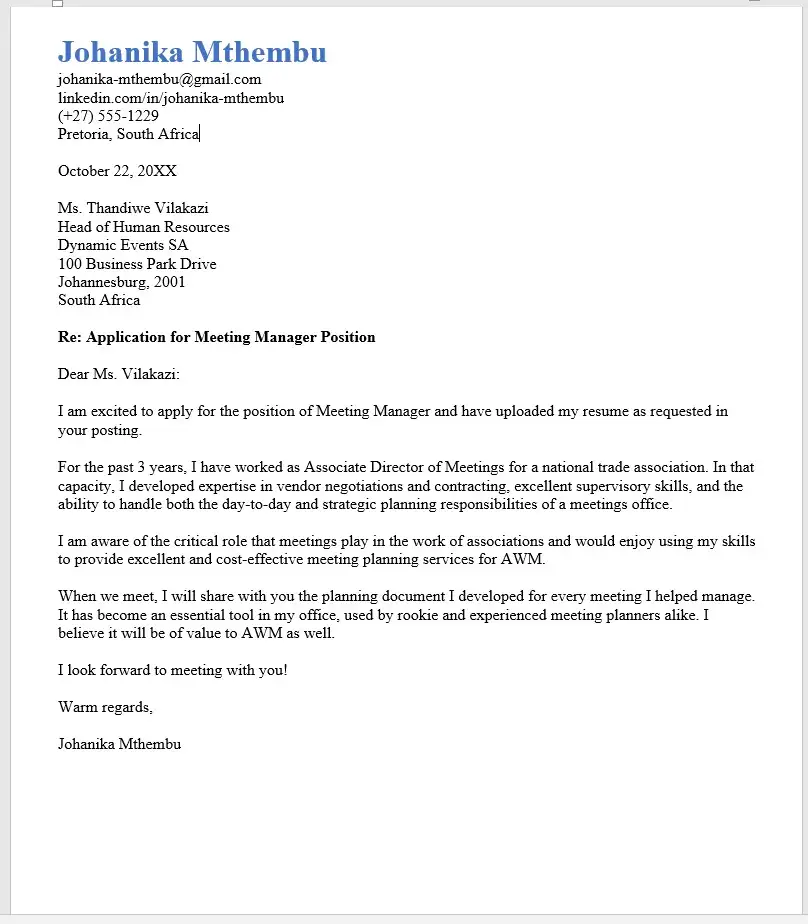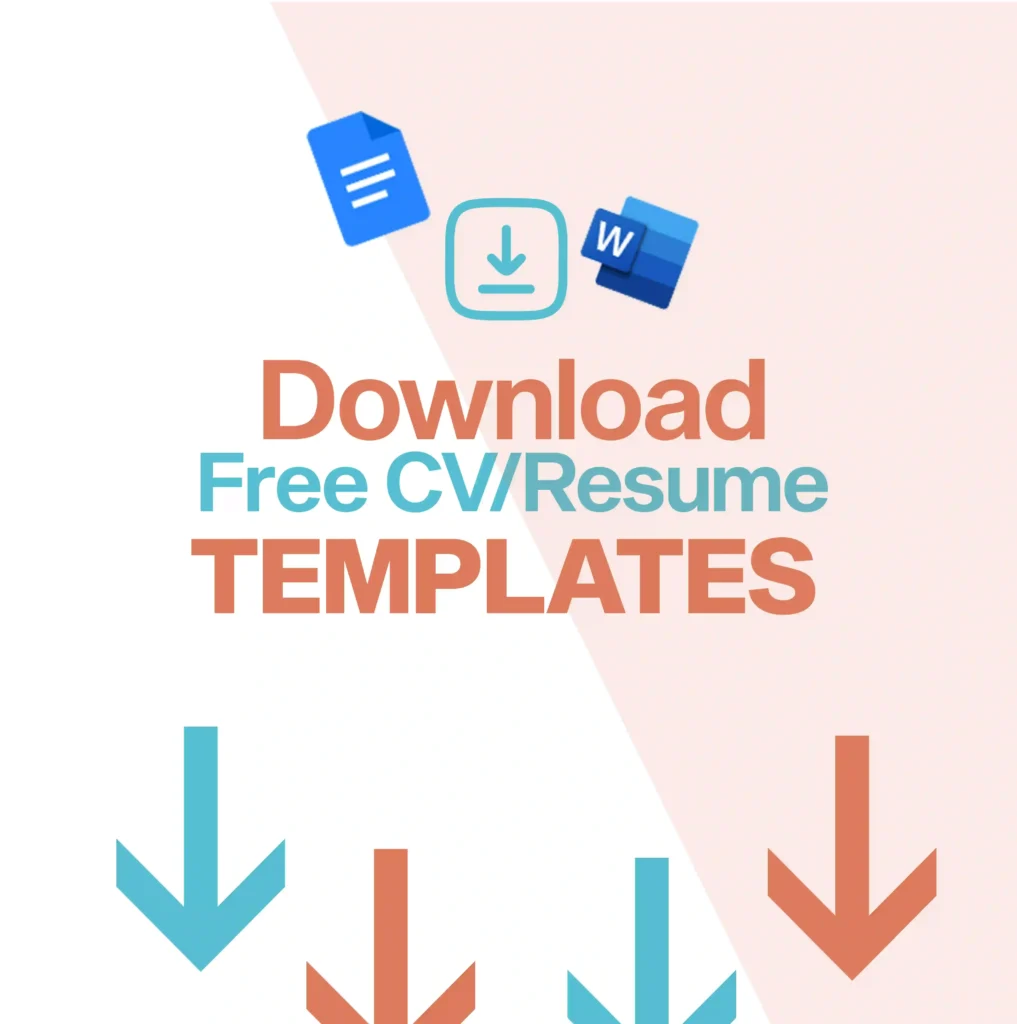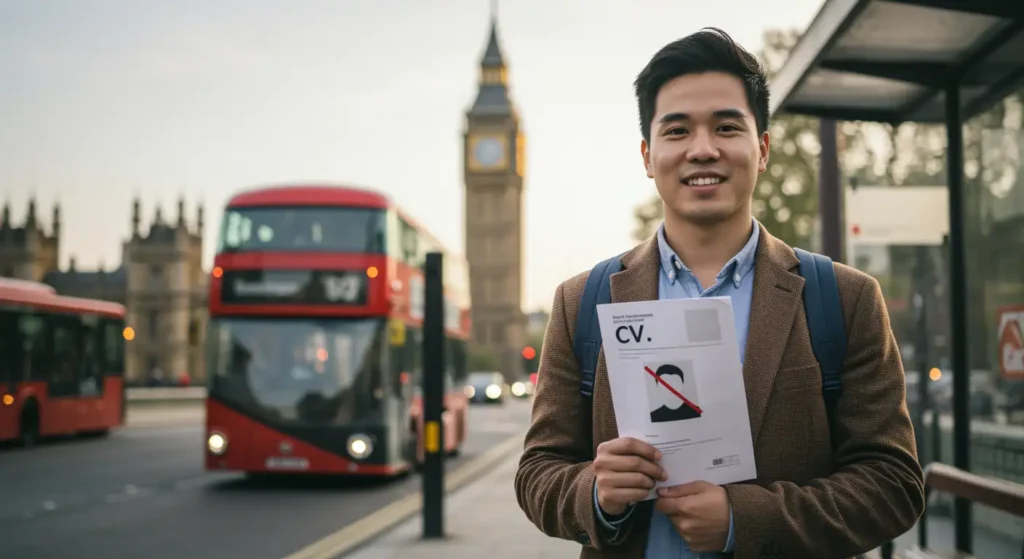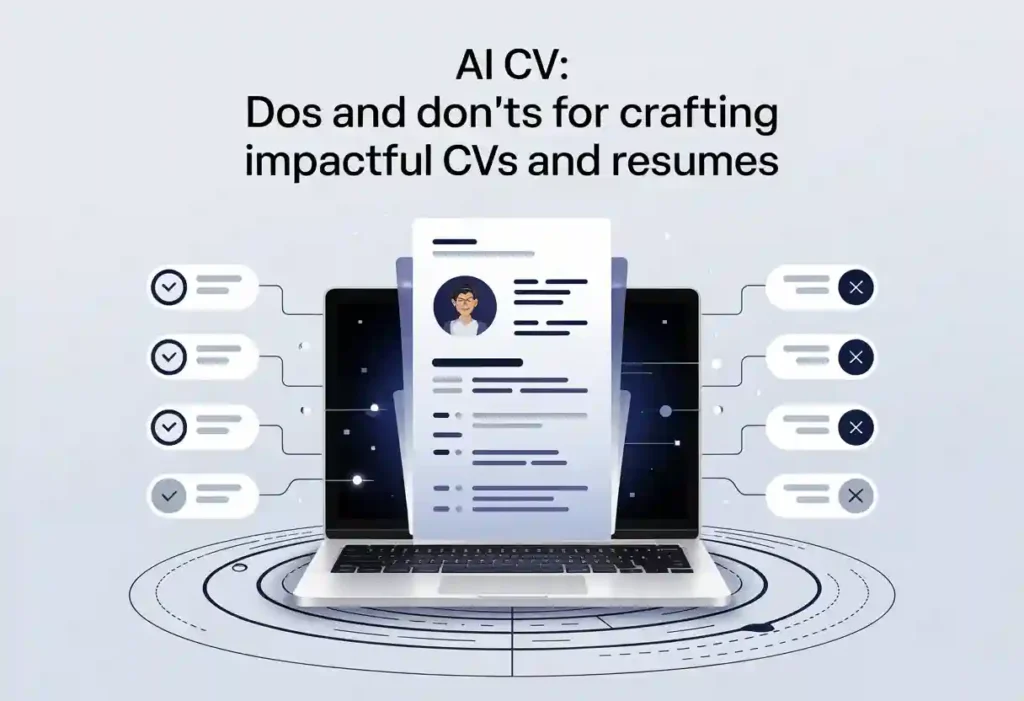Maximising the Cover Letter Advantage
Before your resume or CV gets a glance, your cover letter has already told your story. And that’s your golden opportunity to make a memorable first impression on potential employers.
A great cover letter can make all the difference, setting you apart from other candidates. It showcases your unique value and enthusiasm for the role. But, where do you start?
The following steps are a good place to begin:
Research the company and role.
Write a compelling opening.
Highlight needed skills and experiences.
Show passion and interest.
Tailor your application to match the job title.
Close with confidence
Edit and refine
Next, we’ll dive headlong into each step, providing examples to help you create a captivating cover letter that brings results.
Key Points
Make sure your cover letter is warm, persuasive, and to the point. After your header, explain why the hiring manager should choose you above everyone else.
The body of your cover letter should be about half a page to one page. Most recruiters agree that the shorter, the better.
Ensure that the person who will be reading it is addressed directly. A little research goes a long way here, so try to find the potential employer’s name instead of using a generic greeting.
Tailor your letter to the particular job and company you’re applying to. Recruiters can quickly tell when you haven’t put much time or effort into your application.
Before you start writing, take the time to learn about the company and the role. A quick Google search on the company name can help you gather all the information you need to write a letter that feels personal and informed.
Show enthusiasm! Employers want to know that you’re genuinely interested in the role and enthusiastic about growing within the company. Be sure to mention why this job excites you and how you envision yourself contributing to the company’s growth if they bring you on board.
How to Write a Cover Letter in South Africa to Get More Interviews
Find ways to understand the job advertisement beyond the surface, such as ‘why the job was available.’ You can get the employer’s contact information or connect with the staff on LinkedIn and request such information.
Your first hack is the strategy: ‘How can I position myself on paper to show I am the best candidate to solve the organisation’s problem?’
Start with a strong opening paragraph to draw attention and impress the hiring manager.
Write a non-generic cover letter for each job application. Ensure it’s tailored to the job requirements, even if you’re applying through a recruitment agency.
Use keywords and phrases from the job description to show how your skills and achievements match the company’s needs.
Edit and proofread your cover letter. To enhance its readability, use the free versions of Grammarly and Hemingway.
Understanding the Job Description
Read the job description carefully for each application. Make sure you understand the requirements and responsibilities.
Identify the key skills and qualifications required for the job.
Go the extra mile by researching the company and the role to show your genuine enthusiasm and interest.
List the job requirement keywords and match them with your top skills and work history.
Writing A Cover Letter That Gives You Results
Use the first paragraph to introduce yourself and explain how you came across the job opportunity.
The second paragraph should address the recruiter’s primary concern. Show how your skills, experience, and achievements will help the team succeed.
The third paragraph should convey your enthusiasm and interest in the company and the position.
The fourth (closing) paragraph should convince the recruiter to take the following steps in moving your application forward.
Professional Cover Letters
Use the sample cover letter below for inspiration and consider what to include to make your own stand out.
Example 1: Suitable for Young Professionals, Graduates, and Entry-Level Job Applications ( Download Word version – Free Cover Letter Example for Job Seekers in South Africa)
What sets this cover letter apart:
This letter offers a strong and concise introduction that instantly communicates core skills and essential keywords.
Thus, Johanika’s notice in the fourth paragraph is a promise of value; she indicates how she has developed a tool that has become a must-have for her current office, a pledge she offers to share with her new employer.
Example 2: Best for Young Professionals, Graduates, and Entry-Level Job Seekers (Download Word version)
Highlights of this great cover letter:
This note offers a strong and concise introduction that instantly communicates core skills and essential keywords. Thus, notice that the fourth paragraph is a promise of value.
In concise bullet points, Sipho indicates how she has developed a tool that has become a must-have in her current office, a pledge she offers to share with her new employer.
Example 3: Good for Young Professionals, Graduates, and Entry-Level Job Seekers (Download free Word version)
The strengths of this cover letter are clear:
This job-seeking graduate communicates relevant internships and provides strong and specific cases of work experience.
She then highlights her adaptation and achievements relevant to the job she’s pursuing. By closing with a promise to call, she initiates action in the driver’s seat, rather than simply waiting for Mr. Khumalo to call her.
Example 4: Mid-Career Job Seekers Can Use This Cover Letter (Download free Word version)
The effectiveness of this cover letter is evident:
Lerato introduced each bullet point with a bold keyword. Each highlights a relevant skill that the job needs for the position.
The letter effectively demonstrates how Lerato used those skills and the results she achieved, providing the reader with clear examples of how each paragraph is a quick read.
Example 5: Mid-Career Job Seekers Can Use This Cover Letter (Download free Word version)
This cover letter excels because:
The bold design of the heading makes an immediate positive first impression. Content that addresses the top skills needed for the position reinforces that professional image.
Bold type accents key terms, lending clarity and power to the proposal.
Example of a Well-Written Cover Letter: The 3-Step Formula
Use the following example as a guide to write your unique introduction for your job applications:
STEP 1: Say who you are professionally
- Make it one sentence only
- How do you identify yourself professionally?
STEP 2: Say how you best fit the role
- Re-read the job description
- Identify the primary skills needed and the challenges the hired candidate will solve.
- Say why you uniquely fit to solve those challenges (better to use a story or an explanation)
Why use a story:
- Sharing a story helps you not to rehash what’s already in your CV
STEP 3: Why this organisation?
- Say why you want to work at this company
- One sentence for this is okay
An example:
RE: Customer Service Representative Role at Dee ABC Company
Dear Ms Enfield:
I am a customer service representative with experience handling client inquiries and providing solutions that improve customer satisfaction.
I started my career in customer service when I joined the retail sector. I took on extra responsibilities to manage customer issues and improve service quality. Within a year, I increased customer satisfaction scores by X% by implementing feedback loops and training sessions focused on communication and problem-solving. This progress made me eager to dedicate my career to customer service management, where I can broadly apply my skills.
I’m drawn to Dee Well because of your strong commitment to client relations and innovative approach to investment strategies. Your need for someone to enhance and lead customer service efforts aligns perfectly with my professional experience and personal passion for improving client interactions and satisfaction in the financial sector, which is precisely the kind of work that energises me the most.
Sincerely,
[Your First/Last Name]
Formatting and Content
Use a formal business letter format, with a formal font and layout.
Include your contact details, including your name, email address, and phone number.
Use a professional tone and avoid jargon and slang.
Keep your cover letter focused on the most critical information.
Feel free to use bullet points to make your points concise and clear.
Avoiding Common Cover Letter Mistakes
Avoid using generic cover letters. Add a personal touch to your application instead.
Proofread your cover letter many times to ensure it’s error-free.
Avoid emphasising how badly you need the position when writing a cover letter. Focus, instead, on why you’re qualified to do the job.
Don’t share too much about your situation; this can put the person reviewing the job applications off.
Using Cover Letter Templates
Use free templates to make drafting your cover letter easier.
Customise your cover letter for each job by highlighting your relevant skills and what makes you the most qualified hire.
Use a professional tone and a correct format.
Finalising Your Cover Letter
End your cover letter confidently, showcasing why you’re the right person for the job.
Highlight your top skills and experience, and express your enthusiasm for the position.
Include a call to action, such as requesting an interview or further discussion.
Sign off with a professional closing, such as “Sincerely”, “Best regards, ” or Kind regards”.
Tips: Writing an Engaging Cover Letter
Use ‘power verbs’ generously in your cover letter to demonstrate that you fit the role well.
Refer to specific examples from your CV or resume to highlight your achievements.
You must convince the recruiter that you are confident in your ability to contribute to the team and the company’s goals.
Additional Tips for Gaps, ATS, and Personal Branding
Before you go, consider a few more things to make your cover letter unforgettable
1. Handling Career Shifts and Gaps
Some employers might worry about a gap in employment or a move into a specific job different from your work history. It doesn’t have to stop you. Use a short paragraph in your curriculum vitae or cover letter explaining how your early stages provided unique skills.
Mention any volunteer work or part-time jobs that helped you stay active. Show how your academic career or relevant extracurricular activities enriched your problem-solving. This makes you look like a well-rounded individual who can adapt to different jobs.
2. ATS and the Right Keywords
Most hiring managers use the applicant tracking systems to decide which candidate to consider. These tools scan your cv format for specific keywords.
Always try to match your job description to your professional summary and bullet points. Include key skills and duties that align with the job spec.
That said, you should creatively select your terms when writing a CV (CV stands for “curriculum vitae”). That’s how your strong cv can get read by actual humans.
3. Follow-Up Steps
Picture this: You sent your job application and haven’t heard back. Try a quick follow-up. That single step can create a lasting impression on hiring managers.
Wait a week or two, then send a polite email. Let them know you’re still interested.
4. Personal Branding and Format Differences
How you brand yourself can set you apart from other job applicants. If you have an online portfolio, share the link.
Some roles prefer a printed version, while others want a digital upload. Just keep your CV format consistent. Use one layout for a PDF, or add colour if you’re emailing a design role. This helps potential employers notice a unified brand.
Scenario-Based Examples
- Recent graduate with an education bachelor’s in Marketing? Show your professional summary by mentioning a class project on social media strategy. Highlight your foreign languages if the role needs them.
- Moving into a new job title? Show how your last employment taught you great teamwork or advanced key skills.
- If you had your first job in catering but now want IT, share how you used service-level data to boost operations. That direct link proves you can tackle new job responsibilities.
References and Additional Materials
A great CV can include a final line about an online portfolio, your LinkedIn profile, or code samples (for technical roles). That extra information is relevant for employers to see your style in action.
You could also highlight extracurricular activities that inspired your career moves. Ensure your CV format has a clear professional summary that flags these strengths.
Handy Tips
- Double-check your curriculum vitae for grammatical errors.
- List your educational history in reverse order, starting with the most recent.
- Keep your bullet points on job responsibilities short. No one wants to read an epistle.
- Add part-time jobs if they give you key differences in perspective.
- Focus on skills that reflect problem-solving, communication, and leadership.
A great CV and a strong cover letter can win you more interviews.
Moving Your Cover Letter From Boring to Brilliant
By now, you know the goal of your cover letter is to show the potential employer why you’re the perfect fit for the job.
Start with why you’re applying, highlight your relevant experience and skills, and explain why you align with the role and company.
Finish strong with a closing that expresses your interest and availability. Keep it clear, concise, and impactful.
A good cover letter is a great way to tell your story, even if it might initially seem intimidating to write.
Take it step by step, and you’ll create a letter that positions you as the best and sets you up for success.
If you’re short on time or need help, the CVJury Cover Letter Builder can help. It creates a polished cover letter in minutes.
READ MORE
HOW TO WRITE A CV
NEW EXPERT INSIGHTS
Craft your CV with a clean layout and a strong opening statement. Use a reverse-chronological format and focus only on relevant job details. Customise it for each application.
FREE CV DOWNLOAD
DOWNLOAD FREE CV
WINNING TEMPLATES
Stop. Before you download those CV templates: Let me tell you a story first… About two identical twins and their job hunt: Both used the same templates. Yet one landed multiple interviews. The other? Radio silence. The secret was in the customisation.
- Wendy Enelow and Louise Kursmark (2017). Modernize Your Job Search Letters Get, Noticed… Get Hired. Emerald Career Publishing, USA.
- https://career-advice.jobs.ac.uk/featured-on-homepage/how-to-follow-up-on-job-applications/
- https://www.aacsb.edu/
insights/articles/2021/08/15-steps-to-align-you-skills-with-the-job-description










